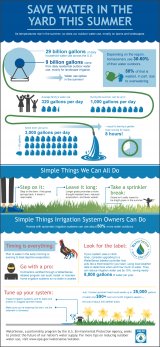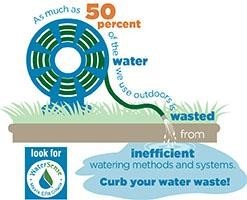When it's Hot


Summer's rising temperatures often coincide with rising outdoor water use, primarily due to an increase in lawn and landscape watering. While using water efficiently is important throughout the year, sometimes the timing of water use can make a big difference for community water supplies—and your water bill.
In most areas, the amount of water homeowners use to keep their lawns green or gardens lush spikes in the summer—two to four times as much water than they use the rest of the year! And those with timed outdoor watering systems often forget to monitor the weather or set their irrigation controllers back in the fall, leading to more overwatering during the cooler months.
You can help use less water and create a healthier landscape by using and sharing these facts about overwatering and tips for reducing outdoor water use.
Add our Save Water This Summer Infographic to your site.

Facts about Summertime Overwatering
- Depending on the region, homeowners use between 30 and 70 percent of their water outdoors.
- Experts estimate that 50 percent of the water we use outdoors goes to waste from evaporation, wind, or runoff due to overwatering.
- Review your water bills and compare your winter water use with your summer use to get a sense of how much extra water you use outdoors when it's hot.
Simple Tips for Saving Water Outdoors
Homes with automatic sprinkler systems can use about 50 percent more water outdoors than those without them. Check your summertime water bill—how does your warmer weather water use compare to winter months? Here are some tips for keeping water use under control:
- Timing is everything: Know how much water your landscape actually needs before you set your sprinkler. Your local utility can offer recommendations for how much water certain plants need in your region and best times to water. Generally, it's best to water lawns and landscapes in the early morning and evening, after the sun goes down, because significant amounts of water can be lost due to evaporation during the heat of the day.
- Look for the label: If your system uses a clock-based controller, consider upgrading to a WaterSense labeled controller that uses local weather data or monitors the moisture level of soil to determine when and how much to water, reducing waste and improving plant health. Replacing a clock-based controller with a WaterSense labeled irrigation controller can save an average home up to 15,000 gallons of water annually. Combining a smart irrigation controller and spray sprinkler bodies that have earned the WaterSense label can save water, time, and money on water and sewer bills.
- Go with a pro: Contractors certified through a WaterSense labeled program can audit, install, or maintain home irrigation systems to ensure water isn't wasted. Make sure you ask for credentials.
- Tune up your system: Inspect irrigation systems and check for leaks and broken or clogged sprinkler heads. Fix sprinkler heads that are broken or spraying on the sidewalk, street, or driveway.
- Play zone defense: When planting, assign areas of your landscape different hydrozones depending on sun/shade exposure, soil and plant types, and type of sprinklers, then adjust your irrigation system or watering schedule based on those zones' specific needs. This helps you avoid overwatering some areas or underwatering others.
Even if your home doesn't have a sprinkler system, there are a number of simple steps you can take to promote a healthier lawn and garden with less water this summer:
- Step on it: Grass doesn't always need water just because it's hot out. Step on the lawn, and if the grass springs back, it doesn't need water. An inexpensive soil moisture sensor can also show the amount of moisture at the plant's roots and discourage overwatering.
- Leave it long: Raise your lawn mower blade. Longer grass promotes deeper root growth, resulting in a more drought-resistant lawn, reduced evaporation, and fewer weeds.
- Give your hose a break: Sweep driveways, sidewalks, and steps rather than hosing them off. And don't forget to check for leaks at your spigot connection and tighten as necessary.
Is your region experiencing below average rainfall this summer? You may be in a drought! Visit our Drought & WaterSense page for helpful information on droughts and what you can do to help your community.
For more tips on reducing outdoor water use, visit our Outdoor pages.
Additional Resources
- Check out the Irrigation Association's Smart Irrigation Month.campaign for additional tips and tools to help you save water outdoors.
- Saving water indoors is always a good idea, too!
